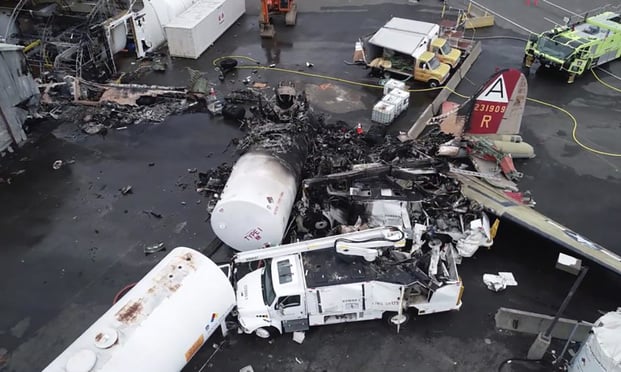Survivors and Families of Those Killed File Suit Over WWII Bomber Crash
"The crash was the result of the negligence, recklessness and callous indifference," the plaintiffs said.
June 10, 2020 at 08:33 AM
5 minute read
 Damage from a World War II-era B-17 bomber plane that crashed on Oct. 2 at Bradley International Airport in Windsor Locks, Connecticut, killing seven people. A lawsuit was filed June 9 against the owners and operators of the airplane. (Courtesy photo)
Damage from a World War II-era B-17 bomber plane that crashed on Oct. 2 at Bradley International Airport in Windsor Locks, Connecticut, killing seven people. A lawsuit was filed June 9 against the owners and operators of the airplane. (Courtesy photo)
The families of those killed and the injured survivors have filed wrongful death claims against the owner of the World War II bomber that crashed and burned at Bradley International Airport in Windsor Locks last year.
"The crash was the result of the negligence, recklessness and callous indifference of the Collings Foundation and its agents," said a complaint filed in Connecticut Superior Court in Hartford. The alleged negligence of the Stow, Massachusetts-based private foundation "resulted in the horrific death of five passengers and serious and permanent bodily and emotional injury to five other passengers," the complaint said.
The pilot and co-pilot were also killed in the Oct. 2, 2019, crash.
Shipman & Goodwin represents eight of the 10 passengers on the plane. The firm declined to comment on the lawsuit. The lawyers who signed the complaint include William Ronalter, Mark Ostrowski and James Bergenn of the firm's Hartford office.
The foundation did not respond immediately to a request for comment. The last message entered on the group's website was Oct. 14, saying, "Please join the Collings Foundation in our thoughts and prayers with those who were on the tragic flight of the B-17 Flying Fortress 'Nine-O-Nine' on Wednesday, October 2nd. We will be forever grateful to the heroic efforts of the first responders at Bradley International Airport and the assistance of all local agencies in the days after the crash."
The foundation also said its team "has been and remains fully cooperative with officials to determine the cause of the crash and we will comment further when facts and details become available."
Meanwhile, the foundation said it has suspended the Wings of Freedom Tour that featured the bomber that crashed.
The complaint said the foundation was established in 1977, initially focusing on living history experiences such as carriage and sleigh rides and antique car rallies. The focus shifted to aviation in the 1980s. The complaint said the foundation eventually acquired vintage aircraft valued at more than $30 million and a collection of military vehicles worth more than $38 million. The military vehicles, called the Jacques Littlefield Collection, were housed at the American Heritage Museum in Stow.
Tickets for short sightseeing flights on the World War II bomber sold for $450 each, according to the complaint. The plaintiffs alleged that the foundation loaded the plane with more passengers than available seats, and that the seats that were available lacked safe and functioning restraint belts. Some of the passengers sat unbuckled on the floor. Some cargo was unsecured, the complaint said.
The plane was a B-17G, a "four engine heavy bomber manufactured by the Douglas Aircraft Company in 1944 for the United States Army Air Corps," the complaint said. "Because it was built so late in the war effort, it did not see combat and was repurposed several times until it was sold for scrap in 1965."
The foundation acquired the plane in the 1980s. The FAA later issued a special airworthiness certificate for "limited" use, the complaint said.
On the day the plane took off for the last time, the crew immediately told the passengers they could get up and look around, according to the complaint. But then quickly after that, the crew chief instructed the passengers to sit back down and buckle up. Eyewitnesses on the ground reported hearing the engines sputter and roar and seeing smoke. The pilot asked the control tower to return to the runway, indicating engine trouble. But the plane hit the ground before the runway, then veered off and hit vehicles and fluid tanks in a deicing facility.
"The crash and subsequent explosion were violent. It ejected many of the passengers from where they were sitting and turned unsecured cargo into dangerous projectiles," the complaint said. "A fire started immediately in the fuselage."
The 208-page complaint includes 73 counts and seeks compensatory and punitive damages, attorney fees and legal costs, plus injunctive relief against further disposition of assets by the foundation.
This content has been archived. It is available through our partners, LexisNexis® and Bloomberg Law.
To view this content, please continue to their sites.
Not a Lexis Subscriber?
Subscribe Now
Not a Bloomberg Law Subscriber?
Subscribe Now
NOT FOR REPRINT
© 2025 ALM Global, LLC, All Rights Reserved. Request academic re-use from www.copyright.com. All other uses, submit a request to [email protected]. For more information visit Asset & Logo Licensing.
You Might Like
View All
K&L Gates Files String of Suits Against Electronics Manufacturer's Competitors, Brightness Misrepresentations
3 minute read
Eleven Attorneys General Say No to 'Unconstitutional' Hijacking of State, Local Law Enforcement
3 minute read
'Battle of the Experts': Bridgeport Jury Awards Defense Verdict to Stamford Hospital
3 minute readLaw Firms Mentioned
Trending Stories
- 1Gibbons Reps Asylum Seekers in $6M Suit Over 2018 ‘Inhumane’ Immigration Policy
- 2DC Judge Chutkan Allows Jenner's $8M Unpaid Legal Fees Lawsuit to Proceed Against Sierra Leone
- 3Internal Whistleblowing Surged Globally in 2024, so Why Were US Numbers Flat?
- 4In Resolved Lawsuit, Jim Walden Alleged 'Retaliatory' Silencing by X of His Personal Social Media Account
- 5Government Attorneys Face Reassignment, Rescinded Job Offers in First Days of Trump Administration
Who Got The Work
J. Brugh Lower of Gibbons has entered an appearance for industrial equipment supplier Devco Corporation in a pending trademark infringement lawsuit. The suit, accusing the defendant of selling knock-off Graco products, was filed Dec. 18 in New Jersey District Court by Rivkin Radler on behalf of Graco Inc. and Graco Minnesota. The case, assigned to U.S. District Judge Zahid N. Quraishi, is 3:24-cv-11294, Graco Inc. et al v. Devco Corporation.
Who Got The Work
Rebecca Maller-Stein and Kent A. Yalowitz of Arnold & Porter Kaye Scholer have entered their appearances for Hanaco Venture Capital and its executives, Lior Prosor and David Frankel, in a pending securities lawsuit. The action, filed on Dec. 24 in New York Southern District Court by Zell, Aron & Co. on behalf of Goldeneye Advisors, accuses the defendants of negligently and fraudulently managing the plaintiff's $1 million investment. The case, assigned to U.S. District Judge Vernon S. Broderick, is 1:24-cv-09918, Goldeneye Advisors, LLC v. Hanaco Venture Capital, Ltd. et al.
Who Got The Work
Attorneys from A&O Shearman has stepped in as defense counsel for Toronto-Dominion Bank and other defendants in a pending securities class action. The suit, filed Dec. 11 in New York Southern District Court by Bleichmar Fonti & Auld, accuses the defendants of concealing the bank's 'pervasive' deficiencies in regards to its compliance with the Bank Secrecy Act and the quality of its anti-money laundering controls. The case, assigned to U.S. District Judge Arun Subramanian, is 1:24-cv-09445, Gonzalez v. The Toronto-Dominion Bank et al.
Who Got The Work
Crown Castle International, a Pennsylvania company providing shared communications infrastructure, has turned to Luke D. Wolf of Gordon Rees Scully Mansukhani to fend off a pending breach-of-contract lawsuit. The court action, filed Nov. 25 in Michigan Eastern District Court by Hooper Hathaway PC on behalf of The Town Residences LLC, accuses Crown Castle of failing to transfer approximately $30,000 in utility payments from T-Mobile in breach of a roof-top lease and assignment agreement. The case, assigned to U.S. District Judge Susan K. Declercq, is 2:24-cv-13131, The Town Residences LLC v. T-Mobile US, Inc. et al.
Who Got The Work
Wilfred P. Coronato and Daniel M. Schwartz of McCarter & English have stepped in as defense counsel to Electrolux Home Products Inc. in a pending product liability lawsuit. The court action, filed Nov. 26 in New York Eastern District Court by Poulos Lopiccolo PC and Nagel Rice LLP on behalf of David Stern, alleges that the defendant's refrigerators’ drawers and shelving repeatedly break and fall apart within months after purchase. The case, assigned to U.S. District Judge Joan M. Azrack, is 2:24-cv-08204, Stern v. Electrolux Home Products, Inc.
Featured Firms
Law Offices of Gary Martin Hays & Associates, P.C.
(470) 294-1674
Law Offices of Mark E. Salomone
(857) 444-6468
Smith & Hassler
(713) 739-1250











